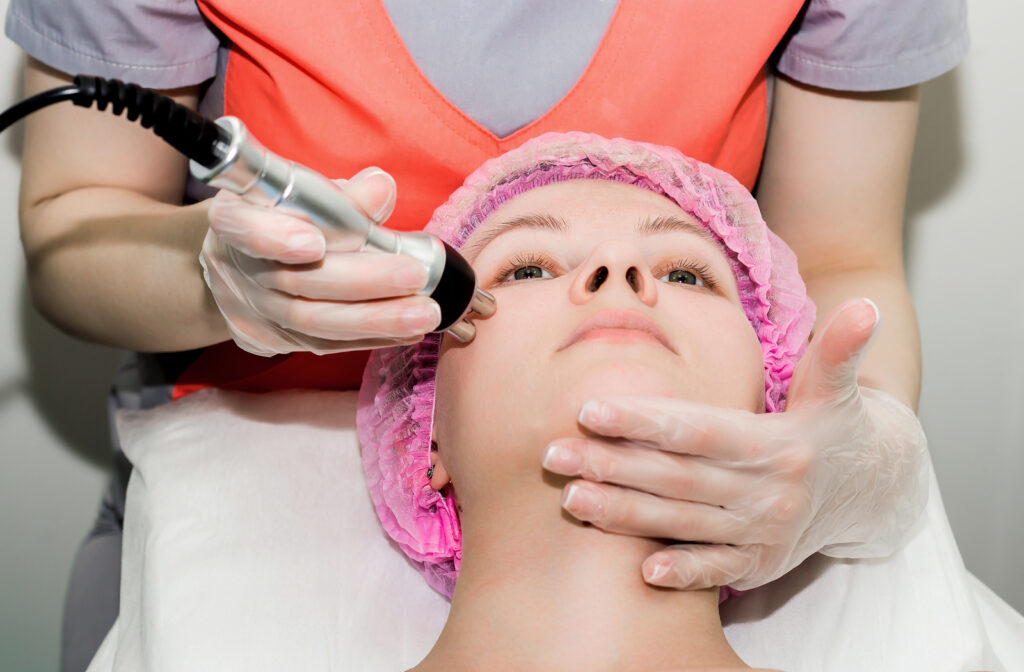As technology advances, the beauty and skincare industry continues to explore innovative treatments that promise youthful and glowing skin without the need for invasive procedures. One such breakthrough is radiofrequency skin tightening, a non-surgical method for firming the skin and reducing the appearance of fine lines and wrinkles. In this article, we’ll explore the science behind radiofrequency skin tightening, its benefits, the procedure, potential risks, and what to expect from treatment.
What Is Radiofrequency Skin Tightening?
Radiofrequency skin tightening is a cosmetic procedure that uses radiofrequency (RF) energy to heat the deep layers of the skin, stimulating collagen production and tissue remodeling. Collagen, a vital protein that gives skin its firmness and elasticity, naturally diminishes as we age, leading to sagging and the formation of wrinkles. Radiofrequency skin tightening offers a way to combat these effects by encouraging the body’s natural regenerative process.
Unlike surgical facelifts, RF treatments are non-invasive and involve no incisions, making it an appealing option for those seeking skin rejuvenation without downtime. It’s a popular choice for individuals who want to firm up loose or sagging skin on the face, neck, abdomen, and other parts of the body.
How Does Radiofrequency Skin Tightening Work?
The radiofrequency skin tightening procedure works by sending RF energy deep into the skin’s layers. This energy heats the tissues, which in turn stimulates collagen and elastin production. The heat from the RF waves causes a controlled injury to the dermis (the middle layer of skin), triggering a natural healing response. As the skin heals, it becomes tighter and more toned over time.
Most RF devices use monopolar or bipolar technology. Monopolar RF delivers energy to a larger treatment area, while bipolar RF is more focused, allowing for targeted treatment. Some advanced systems even combine RF with other technologies like ultrasound or microneedling to enhance the effects of radiofrequency skin tightening.
Benefits of Radiofrequency Skin Tightening
Radiofrequency skin tightening offers several notable benefits, making it a go-to treatment for those looking to enhance their skin’s appearance without surgery. Here are some of the main advantages:

1. Non-Invasive and No Downtime
One of the biggest appeals of radiofrequency skin tightening is that it’s non-invasive. Unlike surgical procedures, there are no cuts or stitches, which means a significantly lower risk of complications. Additionally, there’s little to no downtime, allowing patients to return to their daily activities almost immediately after treatment.
2. Gradual, Natural-Looking Results
RF skin tightening doesn’t produce dramatic overnight results. Instead, it promotes gradual improvements over weeks or months as the body naturally produces more collagen. This leads to subtle, natural-looking enhancements rather than the drastic changes often associated with surgical facelifts.
3. Treats Multiple Areas of the Body
While RF treatments are commonly used on the face, they’re not limited to this area. Radiofrequency skin tightening can be performed on various parts of the body, including the neck, stomach, arms, and thighs. This makes it a versatile option for individuals dealing with loose skin from aging, weight loss, or pregnancy.
4. Minimal Discomfort
The procedure is generally well-tolerated by most patients. A warming sensation is usually felt during the treatment, but it’s typically described as comfortable. Most RF devices are equipped with cooling systems to prevent the skin from overheating, further enhancing patient comfort during the process.
5. Long-lasting Results
While the results of radiofrequency skin tightening aren’t permanent, they can last for several months to years, depending on the individual’s skin condition and lifestyle. Maintenance treatments can extend the effects, making it a worthwhile investment for those committed to long-term skin rejuvenation.
The Procedure: What to Expect
Before undergoing radiofrequency skin tightening, it’s important to consult with a licensed and experienced practitioner who will assess your skin type, concerns, and goals to determine if you’re a suitable candidate. Here’s a general overview of what to expect during the procedure:
1. Pre-Treatment Preparation
Prior to treatment, your skin will be cleansed to remove any oils or makeup. Some providers may apply a topical anesthetic to ensure maximum comfort, although this is not always necessary.
2. The Treatment
During the session, the practitioner will move the RF device across the treatment area. The device delivers controlled RF energy into the skin, heating the deeper layers without damaging the surface. Most sessions last between 30 minutes to an hour, depending on the size of the area being treated.
3. Post-Treatment Care
After the procedure, you may experience mild redness, swelling, or sensitivity, similar to a mild sunburn. These effects typically subside within a few hours. It’s essential to follow any aftercare instructions provided by your practitioner, such as applying sunscreen and avoiding direct sun exposure, as your skin will be more sensitive post-treatment.
Are There Any Risks?
While radiofrequency skin tightening is considered safe for most individuals, as with any cosmetic treatment, there are potential risks. The most common side effects include temporary redness, swelling, and sensitivity. In rare cases, patients may experience burns or blistering if the RF device is not used properly. To minimize risks, it’s crucial to choose a qualified and experienced provider who uses FDA-approved devices.
It’s also worth noting that RF treatments are not suitable for everyone. Individuals with certain medical conditions, such as active infections, pacemakers, or skin disorders, should avoid radiofrequency skin tightening. Always consult with a healthcare provider to ensure the treatment is appropriate for you.
Who Is a Good Candidate for Radiofrequency Skin Tightening?
Radiofrequency skin tightening is ideal for individuals who are beginning to notice mild to moderate skin laxity and want to address it before it becomes more pronounced. It’s particularly effective for those in their 30s to 50s, but older patients with more advanced signs of aging may also benefit from RF treatments.
However, patients with excessive loose skin due to significant weight loss or advanced aging may not achieve the desired results from RF alone and might be better suited for surgical options. A thorough consultation with a cosmetic professional can help determine the most suitable treatment plan based on individual needs and goals.
Conclusion
In today’s fast-paced world, non-invasive treatments like radiofrequency skin tightening offer an effective solution for those looking to maintain a youthful appearance without the risks and recovery time associated with surgery. This cutting-edge technology stimulates collagen production, improves skin texture, and tightens loose skin, all with minimal discomfort and downtime.
While radiofrequency skin tightening may not produce the same dramatic results as a facelift, its natural-looking and gradual effects make it an attractive option for many people. If you’re considering skin rejuvenation, consult with a qualified practitioner to see if this treatment is right for you. With the right approach, you can enjoy firmer, smoother skin and a more youthful complexion for years to come.
